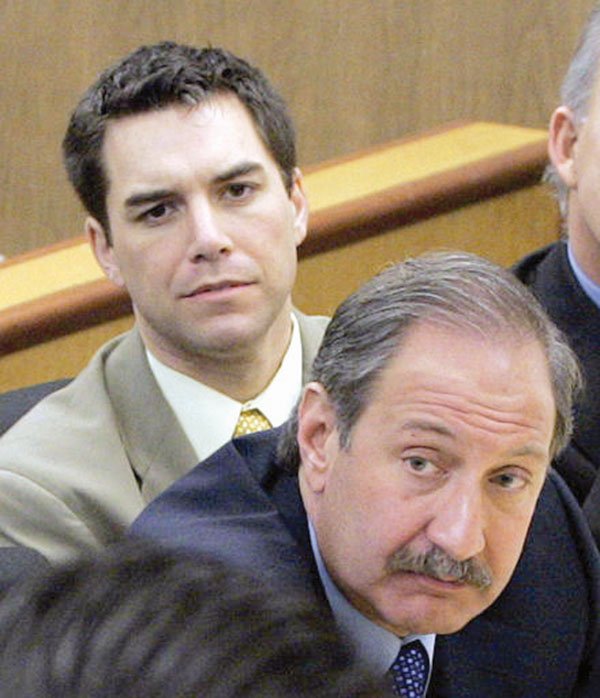Justice reached its conclusion this week concerning the fate of
Modesto’s most famous fertilizer salesman.
Nearly two years after Scott Peterson first reported his
pregnant wife missing on Christmas Eve, the jury on Monday decided
he deserved death as punishment for slaying Laci Peterson and his
unborn son Conner.
Justice reached its conclusion this week concerning the fate of Modesto’s most famous fertilizer salesman.
Nearly two years after Scott Peterson first reported his pregnant wife missing on Christmas Eve, the jury on Monday decided he deserved death as punishment for slaying Laci Peterson and his unborn son Conner.
Peterson’s case was certainly the most hyped-up murder trial since O.J. Simpson faced two homicide charges. As with the Simpson case a decade ago, the media had its feeding frenzy. It covered in detail every sensational scoop. It converted the tragic story into a kind of modern-day morality play – a battle of good versus evil. The deceitful and adulterous Scott starred in the role of “Lucifer.”
Personally over the last two years, I tried avoiding – as much as humanly possible – the continuous media deluge of information on the criminal investigation of Peterson and his subsequent high-profile court trial.
Whenever a faint hint of its stench whiffed from the TV, I hit the remote button. I refused to read newspaper and magazine articles about the murder case. And as politely as I could, I asked to change the subject whenever Scott Peterson came up in ordinary conversation.
And yet, despite my best efforts to avoid it, the crime investigation and trial still managed to creep into my daily life. Through front-page headlines or lead stories on CNN.com, Peterson oozed his way into my brain like some toxic fog pouring through the cracks of my conscious.
Just like Scott Peterson’s own premeditated behavior leading up to his wife and child’s death, there’s something horribly callous about how society behaves with “celebrated” murder stories. “Crimes of the century” they’re sometimes called to drum up the drama.
Part of the problem is how expert the media has become in feeding its audience’s sordid expectations. It promises tempting tidbits of savory scandal.
Seems the human animal can’t get enough of the soap-opera stuff. Maybe it’s hardwired into us. Maybe our modern lives are way too boring. Whatever the reason, the spectacle and the drama of violent death holds an unending fascination for the public.
But converting the murder of a young California woman and her unborn child into a macabre form of entertainment is not something the news media can call its finest hour. Outside the Redwood City courthouse, TV news-cameras and reporters constantly chased down the key players in this unfolding drama. It turned into a hunt for a scrap of titillating fact or a dramatic sound-bite to bait the nightly news lead story.
Our national obsession with this real-life murder story turned into true disrespect for the crime victims. In a twisted partnership, media and audience transformed tragedy into soap opera. We can’t deny the tactless truth of Laci and Conner Peterson’s deaths: the two victims’ blood was used to sell commercial air time and ad space.
It almost seems as if publishers and broadcasters wanted to tell us: “And now, before we get back to more blood, let’s hear a word from our sponsors.” Of course, it would’ve been tacky to actually say this. But the subtext was clear.
No doubt, over-the-top media coverage of sensationalized crime stories gets in the way of justice. Exhibit A: the case of Dr. Sam Sheppard. Sheppard’s case provides an unpleasant lesson on the media’s impact on justice.
His story starts on the night of July 3, 1954, in the quiet Cleveland suburb of Bay Village. After entertaining friends, his wife, Marilyn Sheppard – who was four months pregnant – went upstairs to bed early. Sam stayed in the living room. He dozed in front of the TV while their 7-year-old son was sound asleep.
During the night, Sheppard heard his wife call for help. He ran upstairs and – as he told police – fought with a “bushy-haired” intruder. During the struggle, Sheppard got knocked on the head and lost consciousness. Marilyn Sheppard was brutally beaten to death.
The famous murder case served as the basis for “The Fugitive” TV series as well as the Harrison Ford movie of the same name. Sam Sheppard’s trial became the media circus to end all media circuses. In the build-up to the trial, the newspapers and TV coverage spread tantalizing tales of Sheppard’s infidelity. They described his lies about his affairs with other women. They even published rumors of the doctor’s possible illegitimate child.
The trial itself was a colossal joke on justice. The judge let his courtroom become Bedlam. Disorder and disarray ruled. Cameramen flashed photographs of the defendant, witnesses and jurors. Newspapermen freely handled evidence.
The jury – not surprisingly – returned a guilty verdict. The doctor spent 10 years in prison. The Supreme Court eventually overturned his conviction on the grounds the media interfered with Sheppard receiving a fair trial as mandated by the Constitution.
“The massive, pervasive and prejudicial publicity attending petitioner’s prosecution prevented him from receiving a fair trial consistent with the Due Process Clause of the 14th Amendment,” the Court ruled.
Unfortunately, Los Angeles Superior Court Judge Ito didn’t learn from the Sheppard case. He allowed the news circus to ride rampant in his courtroom. This only helped O.J. Simpson’s defense lawyers skillfully manipulate the media.
But in his Redwood City courtroom during the Peterson trial, to his credit, Judge Alfred Delucchi kept the media circus clowns in check. Despite the public’s engrossed fixation with all matters dealing with the Modesto man’s case, Peterson received a fair trial.
Scott Peterson certainly won’t be the last sensational crime story we’ll see. In the not too distant future, we’ll surely thrill again to some other true-life gory murder that excites our more ignoble curiosities. When that situation arises once more, let’s please remember that the victims – people like Laci Peterson – were real human beings. They had lives. Their stories are not simply soap opera distractions to the dullness of our own daily lives.












